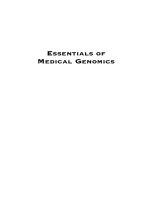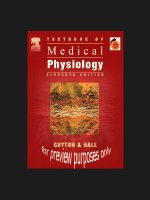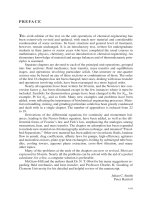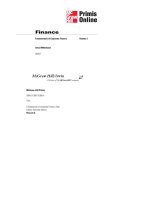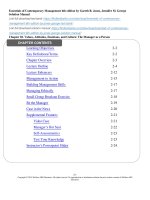Essentials of medical physiology 6th ed k sembulingam, p sembulingam (jaypee, 2012)
Bạn đang xem bản rút gọn của tài liệu. Xem và tải ngay bản đầy đủ của tài liệu tại đây (35.73 MB, 1,113 trang )
Essentials of
Medical Physiology
Essentials of
Medical Physiology
Sixth Edition
K Sembulingam PhD
and
Prema Sembulingam PhD
Madha Medical College & Research Institute
Kundrathur Main Road, Kovur, Thandalam (Near Porur)
Chennai, Tamil Nadu, India
Formerly
MR Medical College
Gulbarga, Karnataka, India
Sri Ramachandra Medical College and Research Institute
Chennai, Tamil Nadu, India
School of Health Sciences, Universiti Sains Malaysia
Kelantan, Malaysia
Sri Lakshmi Narayana Institute of Medical Sciences
Puducherry, India
Sri Manakula Vinayagar Medical College and Hospital
Puducherry, India
and
Shri Sathya Sai Medical College and Research Institute
Kanchipuram, Tamil Nadu, India
®
JAYPEE BROTHERS MEDICAL PUBLISHERS (P) LTD
New Delhi • Panama City • London • Dhaka • Kathmandu
®
Jaypee Brothers Medical Publishers (P) Ltd
Headquarters
Jaypee Brothers Medical Publishers (P) Ltd
4838/24, Ansari Road, Daryaganj
New Delhi 110 002, India
Phone: +91-11-43574357
Fax: +91-11-43574314
Email:
Overseas Offices
J.P. Medical Ltd
83 Victoria Street, London
SW1H 0HW (UK)
Phone: +44-2031708910
Fax: +02-03-0086180
Email:
Jaypee Brothers Medical Publishers (P) Ltd
17/1-B Babar Road, Block-B, Shaymali
Mohammadpur, Dhaka-1207
Bangladesh
Mobile: +08801912003485
Email:
Jaypee-Highlights Medical Publishers Inc.
City of Knowledge, Bld. 237, Clayton
Panama City, Panama
Phone: + 507-301-0496
Fax: + 507-301-0499
Email:
Jaypee Brothers Medical Publishers (P) Ltd
Shorakhute, Kathmandu
Nepal
Phone: +00977-9841528578
Email:
Website: www.jaypeebrothers.com
Website: www.jaypeedigital.com
© 2012, Jaypee Brothers Medical Publishers
All rights reserved. No part of this book may be reproduced in any form or by any means without the prior permission of the publisher.
Inquiries for bulk sales may be solicited at:
This book has been published in good faith that the contents provided by the authors contained herein are original, and is intended for educational
purposes only. While every effort is made to ensure accuracy of information, the publisher and the authors specifically disclaim any damage, liability,
or loss incurred, directly or indirectly, from the use or application of any of the contents of this work. If not specifically stated, all figures and tables
are courtesy of the authors. Where appropriate, the readers should consult with a specialist or contact the manufacturer of the drug or device.
Essentials of Medical Physiology
First Edition: 1999
Second Edition: 2000
Third Edition: 2004
Fourth Edition: 2006
Fifth Edition: 2010
Sixth Edition: 2012
ISBN 978-93-5025-936-8
Printed at
Dedicated to
Our beloved students
Foreword to the Sixth Edition
Madha Medical college & ReseaRch institute
Approved by Medical Council of India, New Delhi,
Affiliated to Tamil Nadu Dr. M.G.R. Medical University, Chennai, Proc. No. AffIn. III (3)/4206/2010
Thandalam, Kovur (Near Porur), Chennai-600 122. Phone : 044 - 2478 0333, 2478 0055
E-mail:
Dr S MaDaN KuMar MD, Dip. A & E
Director
It is my privilege and pleasure to give this foreword to sixth edition of the textbook Essentials of Medical Physiology
written by two of our dedicated and renowned teachers Dr K Sembulingam and Dr Prema Sembulingam. Since
the publication of first edition in the year 1999, this book has been accepted by the faculty of many universities in
and out of country. It has become popular among medical, dental and paramedical students because of its elegant
presentation, simple language and clear illustrations with diagrams, flow charts and tables.
The authors have taken concerted efforts to improve the contents and update the information in every subsequent
edition of this book. This sixth edition with newly formatted and updated tables, flow charts and self-explanatory
diagrams will help the students in better understanding and performance in various types of examinations. Clinical
physiology with updated information in this edition will help the students for their clinical knowledge to a great extent.
I congratulate Dr K Sembulingam and Dr Prema Sembulingam on their great effort in bringing sixth edition of this
book.
Dr S Madan Kumar MD, Dip. A & E
Director
Madha Medical College & Research Institute
Thandalam, Kovur (Near Porur)
Chennai, Tamil Nadu, India
Foreword to the First Edition
sRi RaMachandRa Medical college and ReseaRch institute
(deeMed univeRsity)
1, RAMAChANDRA NAGAR, PoRUR, ChENNAI-600 116
Dr TK ParTha SaraThy FRCs (C) FACs
Diplomate of the American Board of surgery
vICE-ChANCElloR
off
Fax
: 4828027-29, 31-33
: 091-44-48277008
Telex : 41-25050 PCo IN
It is indeed with a great sense of pleasure and privilege that I give this foreword to the book Essentials of Medical
Physiology written by two of our dedicated teachers Dr K Sembulingam and Dr Prema Sembulingam. The students
have always appreciated the efforts of these two teachers and their ability to make physiology easily comprehended
and interesting. Why one more book in physiology, is what I asked myself first before I reviewed the book. The book
has been largely directed to the broad and specific needs of the undergraduate students, and simplicity and clarity
have been emphasized. The students can easily assimilate the logical sequence in which the subjects have been
presented not only for them to understand the same but also perform well in the various types of objective and
routine examinations.
Several readily understandable diagrams and tables have been included to make subject comprehension and
revision easy. Applied physiology, clinical importance and altered situations in pediatrics, geriatrics and pregnancy
have been well brought out. The approach utilized in dealing with the subject of physiology would be appreciated
by other teachers as well. I have no doubts that this will be a valuable addition to the armamentarium of a student
of physiology who is preparing for examination and is seeking a strong foundation to build further on.
Here at Sri Ramachandra Medical College and Research Institute (Deemed University), Chennai, Tamil Nadu, India,
the faculty involved in writing and editing books of this nature are greatly appreciated, and I as its Vice-Chancellor
wish to congratulate the Sembulingams on their great effort.
TK Partha Sarathy FRCS (C) FACS
Diplomate of the American Board of Surgery
Vice-Chancellor
Sri Ramachandra Medical College and Research
Institute (Deemed University)
Porur, Chennai, Tamil Nadu, India
Preface to the Sixth Edition
With this Sixth edition, Sembulingam’s Essentials of Medical Physiology enters into its second decade and the core
subject matter with updated physiological information remain as green as ever. We live in an era where the thirst
for knowledge and urge for learning is so much increased that even a layman knows the fundamentals of common
disorders like diabetes mellitus, hypertension, jaundice, etc. So, it becomes doubly important to fulfill the expectations
of the educated mass, especially in medical field.
We are humbly thankful and heavenly happy for the popularity of this book among the undergraduate and
postgraduate students of medical, dental and paramedical courses, doctors and other health professionals in and
out of our country.
Like many other successful textbooks, this book also has sailed through the years smoothly, fruitfully and
successfully. May be because, it meets the needs of every group of the readers. Students are happy because it is
student-friendly while reading, and exam-friendly while revising. Knowledge seekers are happy because they get
the updated and recent developments in the field of physiology. Doctors are happy because applied aspects are
covered adequately.
Our thirst for improving this textbook is growing every year by seeing outright acceptance of this book by the
students, and the appreciation and overwhelming support given by our fellow teachers. The most comments and
the suggestions, we receive from our readers, are responsible for better shaping of this book in every edition.
This edition is enriched with addition of many more flow charts, tables and descriptive diagrams to make the
subject matter easier and approachable for all class of students. Many chapters are upgraded as per the suggestions
from our colleagues and fellow teachers from various institutes and universities in and out of India.
Our thirst for improving this book is still alive. The improvement is possible only by the comments and suggestions
expressed by the readers. So, we welcome the opinions, comments and valuable suggestions from one and all who
happen to come across this book.
K Sembulingam
Prema Sembulingam
Preface to the First Edition
The need for having a simple book with basic principles of Medical Physiology has been felt since long. A sincere and
maiden attempt has been made with the idea of fulfilling the requirements of present-day curriculum. The script of
the book is formatted in such a way that it will be suitable not only for medical students, but also for dental students
and the students of allied health subjects like Physiotherapy, Occupational Therapy, Pharmacy, Nursing, Speech,
Hearing and Language, etc.
Written in a textbook form, this book encompasses the knowledge of basic principles of physiology in each system.
An attempt is also made to describe the applied physiology in each system.
To give an idea of the matters to be studied, the topics are listed at the beginning of each chapter. Most of the
figures are given in schematic form to enable students to understand and reproduce the facts. The probable questions
given for each section will help the students preparing for examinations. However, it will be ideal for the students to
read each section thoroughly before referring to the questions.
We will be very happy to receive opinions, comments and valuable suggestions from all our senior colleagues,
fellow teachers and students so that, every aspect of the book can be reviewed in succeeding editions.
K Sembulingam
Prema Sembulingam
Acknowledgments
We express our profound gratitude to Late Mr NPV Ramasamy Udayar, Founder Chancellor, Sri Ramachandra
Medical College and Research Institute (Deemed University), Chennai, Tamil Nadu, India for his keen interest in all
the academic activities of the faculty members.
We would like to express our sincere gratitude to Sri VR Venkatachalam, the Chancellor of Sri Ramachandra
Medical College and Research Institute (Deemed University) for accepting to grace the occasion of ‘Book Releasing
Ceremony’ of Essentials of Medical Physiology—first edition and for releasing the book. We are very much thankful
to the former Vice-Chancellor of this University Dr TK Partha Sarathy, who honored us by attending the function and
received the first copy of the book. We are also overwhelmed by his magnanimity for his encouragement and for
going through the entire script before giving the foreword.
We sincerely thank Mrs Radha Venkatachalam, Registrar and Administrative Director, Sri Ramachandra Medical
College and Research Institute (Deemed University), who always encouraged the faculty of the university for
publications.
We thank Dr Sylvia Walter, Professor Emeritus, Department of Physiology, Sri Ramachandra Medical College
and Research Institute (Deemed University), who is the inspiration for us to bring out this book. We are also indebted
to her for giving many valuable clues to modify the script in many chapters. Our special thanks to Dr V Srinivasan,
Former Professor and Head, Department of Physiology, Sri Ramachandra Medical College and Research Institute
(Deemed University) for his strong belief in this project, constant encouragement and valuable suggestions. We are
very much grateful to Dr V Srinivasan for his keen interest and valuable suggestions for upgrading the script in each
edition.
We thank all our fellow teachers and senior professors from various institutes and universities in and out of India
for their comments and suggestions, which enabled us to bring out each edition of the book successfully.
We are deeply indebted to our students of Sri Ramachandra Medical College and Research Institute (Deemed
University), Chennai, Tamil Nadu, India and MR Medical College, Gulbarga, Karnataka, India who were the spirit
behind the idea of bringing out this book.
Our special thanks to Dr M Chandrasekar, Vice-Principal and Head, Department of Physiology, Meenakshi Medical
College, Kanchipuram, Tamil Nadu, India for writing a review article on this book in the Journal ‘Biomedicine’
(Vol 20, No. 1). Many valuable suggestions from him enabled us to upgrade the book in each edition.
We are grateful to Professor Mafauzy Mohamad, Director, Health Campus, Universiti Sains Malaysia, Kelantan,
Malaysia for providing the photos of endocrine disorder patients. We are thankful to Dr Nivaldo Medeiros, Former
Director of Hematology and Cytology Services, Central Laboratory, University of Säo Paulo, School of Medicine,
USA for giving us the hematology pictures.
Our profound thanks are due to Dr S Peter, Founder and Chairman, Madha Group of Academic Institutions for
the recognition, appreciation and encouragement given to us in bringing out this edition. We are thankful to
Dr S Madan Kumar, Director, Madha Medical College & Research Institute for his keen interest in publishing this
edition. We also thank him for accepting and rendering foreword for this edition. We thank Dr K Gajendran, Principal,
Madha Medical College & Research Institute for his constant encouragement in bringing out this edition.
We are thankful to Shri Jitendar P Vij (CEO), Mr Tarun Duneja (Director-Publishing) and Mr KK Raman (Production
Manager) of M/s Jaypee Brothers Medical Publishers (P) Ltd, New Delhi, India for publishing the book in the same
format as we wanted. We thank Ms Chetna Malhotra Vohra (Senior Business Executive Manager) for coordinating
the processing of this edition. We thank Ms Sajini SV (Project Leader), Ms Hemalata Malini B and Mr Samiulla (DTP
Operators); Ms Nandini N, Ms Ramya VR, Ms Bhavya M, and Ms Nikita G (Proofreaders) of Bengaluru Production
Unit, M/s Jaypee Brothers Medical Publishers (P) Ltd, Bengaluru Branch, for their wholehearted contribution while
formatting the book. We also thank Ms Shilpa K Bhat (Graphic Designer), of Bengaluru Production Unit for making
the figures attractive.
Special Acknowledgments
We sincerely acknowledge the following fellow teachers for their valuable suggestions. All the points suggested by
them were acknowledged and incorporated in this edition.
1. Dr M Chandrasekar
Vice Principal and Head
Department of Physiology
Meenakshi Medical College
Kanchipuram, Tamil Nadu, India
2. Dr P Sai Kumar
Vice Principal and Professor
Department of Physiology
Sri Balaji Medical College and Hospital
Chennai, Tamil Nadu, India
3. Dr B Vishwanatha Rao
Professor
Department of Physiology
Madras Medical College
Chennai, Tamil Nadu, India
4. Dr K Sarayu
Professor and Head
Department of Physiology
KAT Viswanathan Government Medical College
Trichy, Tamil Nadu, India
5. Dr D Venkatesh
Professor
Department of Physiology
MS Ramaiah Medical College
Bengaluru, Karnataka, India
6. Dr S Manikandan
Associate Professor
Department of Physiology
Tagore Medical College
Chennai, Tamil Nadu, India
7. Dr NV Mishra
Associate Professor
Department of Physiology
Medical College
Nagpur (MS), Maharashtra, India
8. Dr KS Udayashankar
Professor and Head
Department of Physiology
Sri Rajarajeshwari Medical College and Hospital
Bengaluru, Karnataka, India
9. Dr MG Hymavthi
Professor
Department of Physiology
Sri Rajarajeshwari Medical College and Hospital
Bengaluru, Karnataka, India
Contents
SECTIoN 1
GENERAL PHySIoLoGy
1.
2.
3.
4.
5.
Cell .....................................................................................................................................3
Cell Junctions .................................................................................................................22
Transport through Cell Membrane ................................................................................27
Homeostasis ...................................................................................................................38
Acid-Base Balance .........................................................................................................42
SECTIoN 2
BLooD AND BoDy FLUIDS
6.
7.
8.
9.
10.
11.
12.
13.
14.
15.
16.
17.
18.
19.
20.
21.
22.
23.
24.
25.
26.
27.
Body Fluids .....................................................................................................................51
Blood ...............................................................................................................................58
Plasma Proteins..............................................................................................................61
Red Blood Cells ..............................................................................................................66
Erythropoiesis ................................................................................................................71
Hemoglobin and Iron Metabolism .................................................................................77
Erythrocyte Sedimentation Rate ...................................................................................83
Packed Cell Volume and Blood Indices........................................................................86
Anemia.............................................................................................................................89
Hemolysis and Fragility of Red Blood Cells ................................................................95
White Blood Cells ...........................................................................................................97
Immunity........................................................................................................................107
Platelets .........................................................................................................................122
Hemostasis ...................................................................................................................127
Coagulation of Blood ...................................................................................................129
Blood Groups................................................................................................................139
Blood Transfusion ........................................................................................................146
Blood Volume................................................................................................................148
Reticuloendothelial System and Tissue Macrophage...............................................151
Spleen ............................................................................................................................153
Lymphatic System and Lymph ....................................................................................155
Tissue Fluid and Edema ..............................................................................................159
xviii
Essentials of Medical Physiology
SECTIoN 3
MUSCLE PHySIoLoGy
28.
29.
30.
31.
32.
33.
34.
35.
Classification of Muscles.............................................................................................167
Structure of Skeletal Muscle .......................................................................................169
Properties of Skeletal Muscle......................................................................................176
Changes during Muscular Contraction ......................................................................188
Neuromuscular Junction .............................................................................................200
Smooth Muscle .............................................................................................................204
Electromyogram and Disorders of Skeletal Muscle ..................................................210
Endurance of Muscle ...................................................................................................214
SECTIoN 4
DIGESTIVE SySTEM
36.
37.
38.
39.
40.
41.
42.
43.
44.
45.
46.
47.
Introduction to Digestive System ...............................................................................219
Mouth and Salivary Glands .........................................................................................223
Stomach ........................................................................................................................230
Pancreas........................................................................................................................241
Liver and Gallbladder ...................................................................................................249
Small Intestine ..............................................................................................................261
Large Intestine ..............................................................................................................266
Movements of Gastrointestinal Tract .........................................................................270
Gastrointestinal Hormones .........................................................................................281
Digestion, Absorption and Metabolism of Carbohydrates .......................................287
Digestion, Absorption and Metabolism of Proteins ..................................................290
Digestion, Absorption and Metabolism of Lipids ......................................................292
SECTIoN 5
RENAL PHySIoLoGy AND SKIN
48.
49.
50.
51.
52.
53.
54.
55.
56.
Kidney............................................................................................................................301
Nephron .........................................................................................................................304
Juxtaglomerular Apparatus .........................................................................................309
Renal Circulation ..........................................................................................................312
Urine Formation ............................................................................................................315
Concentration of Urine.................................................................................................325
Acidification of Urine and Role of Kidney in Acid-Base Balance ............................330
Renal Function Tests ...................................................................................................333
Renal Failure .................................................................................................................337
Contents
57.
58.
59.
60.
61.
62.
63.
Micturition .....................................................................................................................339
Dialysis and Artificial Kidney ......................................................................................346
Diuretics ........................................................................................................................348
Structure of Skin...........................................................................................................351
Functions of Skin .........................................................................................................354
Glands of Skin ..............................................................................................................356
Body Temperature ........................................................................................................359
SECTIoN 6
ENDoCRINoLoGy
64.
65.
66.
67.
68.
69.
70.
71.
72.
73.
Introduction to Endocrinology ....................................................................................367
Hormones ......................................................................................................................371
Pituitary Gland ..............................................................................................................375
Thyroid Gland ...............................................................................................................388
Parathyroid Glands and Physiology of Bone ............................................................399
Endocrine Functions of Pancreas ..............................................................................415
Adrenal Cortex ..............................................................................................................425
Adrenal Medulla ............................................................................................................439
Endocrine Functions of other organs .......................................................................444
Local Hormones ...........................................................................................................447
SECTIoN 7
REPRoDUCTIVE SySTEM
74.
75.
76.
77.
78.
79.
80.
81.
82.
83.
84.
85.
86.
87.
88.
Male Reproductive System ..........................................................................................455
Seminal Vesicles...........................................................................................................467
Prostate Gland ..............................................................................................................468
Semen ............................................................................................................................470
Female Reproductive System .....................................................................................473
ovary .............................................................................................................................476
Menstrual Cycle ............................................................................................................482
ovulation .......................................................................................................................492
Menopause ....................................................................................................................494
Infertility .......................................................................................................................496
Pregnancy and Parturition...........................................................................................498
Placenta .........................................................................................................................505
Pregnancy Tests ...........................................................................................................508
Mammary Glands and Lactation .................................................................................510
Fertility Control .............................................................................................................513
xix
xx
Essentials of Medical Physiology
SECTIoN 8
CARDIoVASCULAR SySTEM
89.
90.
91.
92.
93.
94.
95.
96.
97.
98.
99.
100.
101.
102.
103.
104.
105.
106.
107.
108.
109.
110.
111.
112.
113.
114.
115.
116.
117.
Introduction to Cardiovascular System .....................................................................519
Properties of Cardiac Muscle ......................................................................................525
Cardiac Cycle ................................................................................................................533
Heart Sounds ................................................................................................................544
Cardiac Murmur ............................................................................................................549
Electrocardiogram (ECG).............................................................................................551
Vector.............................................................................................................................558
Arrhythmia ....................................................................................................................562
Effect of Changes in Electrolyte Concentration on Heart ........................................570
Cardiac output..............................................................................................................572
Heart-Lung Preparation ...............................................................................................582
Cardiac Function Curves .............................................................................................584
Heart Rate......................................................................................................................587
Hemodynamics .............................................................................................................595
Arterial Blood Pressure ...............................................................................................602
Venous Pressure ..........................................................................................................617
Capillary Pressure ........................................................................................................620
Arterial Pulse ................................................................................................................622
Venous Pulse ................................................................................................................627
Coronary Circulation ....................................................................................................629
Cerebral Circulation .....................................................................................................634
Splanchnic Circulation.................................................................................................638
Capillary Circulation.....................................................................................................640
Circulation through Skeletal Muscle ..........................................................................644
Cutaneous Circulation .................................................................................................646
Fetal Circulation and Respiration ...............................................................................648
Hemorrhage ..................................................................................................................651
Circulatory Shock and Heart Failure ..........................................................................654
Cardiovascular Adjustments during Exercise ...........................................................664
SECTIoN 9
RESPIRAToRy SySTEM AND ENVIRoNMENTAL PHySIoLoGy
118.
119.
120.
121.
Physiological Anatomy of Respiratory Tract .............................................................673
Pulmonary Circulation .................................................................................................678
Mechanics of Respiration ............................................................................................682
Pulmonary Function Tests...........................................................................................690
Contents
122.
123.
124.
125.
126.
127.
128.
129.
130.
131.
132.
Ventilation .....................................................................................................................700
Inspired Air, Alveolar Air and Expired Air ..................................................................703
Exchange of Respiratory Gases .................................................................................705
Transport of Respiratory Gases .................................................................................711
Regulation of Respiration ............................................................................................716
Disturbances of Respiration........................................................................................723
High Altitude and Space Physiology ..........................................................................737
Deep Sea Physiology ...................................................................................................743
Effects of Exposure to Cold and Heat ........................................................................746
Artificial Respiration ....................................................................................................749
Effects of Exercise on Respiration .............................................................................751
SECTIoN 10
NERVoUS SySTEM
133.
134.
135.
136.
137.
138.
139.
140.
141.
142.
143.
144.
145.
146.
147.
148.
149.
150.
151.
152.
153.
154.
155.
156.
157.
Introduction to Nervous System .................................................................................757
Neuron ...........................................................................................................................759
Classification of Nerve Fibers .....................................................................................764
Properties of Nerve Fibers...........................................................................................766
Degeneration and Regeneration of Nerve Fibers ......................................................770
Neuroglia .......................................................................................................................773
Receptors ......................................................................................................................775
Synapse .........................................................................................................................780
Neurotransmitters ........................................................................................................787
Reflex Activity ...............................................................................................................795
Spinal Cord ...................................................................................................................803
Somatosensory System and Somatomotor System .................................................828
Physiology of Pain .......................................................................................................838
Brainstem ......................................................................................................................844
Thalamus .......................................................................................................................847
Internal Capsule............................................................................................................853
Hypothalamus ...............................................................................................................855
Cerebellum ....................................................................................................................863
Basal Ganglia ................................................................................................................878
Cerebral Cortex.............................................................................................................884
Limbic System ..............................................................................................................898
Reticular Formation......................................................................................................901
Preparations of Animals for Experimental Studies ...................................................906
Proprioceptors ..............................................................................................................908
Posture and Equilibrium ..............................................................................................913
xxi
158.
159.
160.
161.
162.
163.
164.
Vestibular Apparatus ....................................................................................................919
Electroencephalogram (EEG) ......................................................................................929
Physiology of Sleep .....................................................................................................931
Epilepsy .........................................................................................................................935
Higher Intellectual Functions ......................................................................................937
Cerebrospinal Fluid (CSF) ...........................................................................................949
Autonomic Nervous System (ANS).............................................................................954
SECTIoN 11
SPECIAL SENSES
165.
166.
167.
168.
169.
170.
171.
172.
173.
174.
175.
176.
177.
Structure of the Eye .....................................................................................................965
Visual Process ..............................................................................................................978
Field of Vision ...............................................................................................................987
Visual Pathway .............................................................................................................989
Pupillary Reflexes.........................................................................................................994
Color Vision ..................................................................................................................999
Errors of Refraction....................................................................................................1004
Structure of Ear ..........................................................................................................1007
Auditory Pathway .......................................................................................................1013
Mechanism of Hearing ...............................................................................................1016
Auditory Defects .........................................................................................................1022
Sensation of Taste ......................................................................................................1024
Sensation of Smell .....................................................................................................1028
• Index ..................................................................................................................................1033
Introduction
Physiology is the most fascinating and ancient branch of science. It is fascinating because, it unfolds the mystery of
complicated functional aspects of individual organs in the body. It is ancient because, it exists ever since the origin
of life. Even before knowing the language, culture and society, man knew about the hunger, thirst, pain and fear
which are the basics of physiology.
Physiology is defined as the study of functions of various systems and different organs of the body. Physiology
is of different types namely, Human Physiology, Animal Physiology and Plant Physiology. Human Physiology and
Animal Physiology are very much inter-related. Knowledge of Human Physiology is essential to understand the other
allied subjects like Biochemistry, Pharmacology, Pathology, Medicine, etc. However, it is worthwhile to have a brief
knowledge of anatomy of different systems and various organs to understand the principles of Human Physiology.
The basic physiological functions include, provision of oxygen and nutrients, removal of metabolites and other
waste products, maintenance of blood pressure and body temperature, hunger and thirst, locomotor functions, special
sensory functions, reproduction and the higher intellectual functions like learning and memory.
In the unicellular organisms, all the physiological functions are carried out by simple diffusion through the cell
membrane. Because of the evolutionary and ecological changes over the years, individual system is developed for
each function such as digestive system, cardiovascular system, respiratory system, excretory system, etc. Every
system in the body is independent structurally and functionally yet, all the systems are interdependent.
Human Physiology is usually studied under the following headings:
1.
2.
3.
4.
5.
6.
7.
8.
9.
10.
11.
General Physiology
Blood and Body Fluids
Muscle Physiology
Digestive System
Renal Physiology and Excretion
Endocrinology
Reproductive System
Cardiovascular System
Respiratory System and Environmental Physiology
Nervous System
Special Senses
Section
1
1.
2.
3.
4.
5.
General Physiology
Cell .............................................................................................................. 3
Cell Junctions ............................................................................................ 22
Transport through Cell Membrane ............................................................ 27
Homeostasis ............................................................................................. 38
Acid-base Balance .................................................................................... 42

